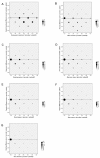Health care providers underestimate symptom intensities of cancer patients: a multicenter European study
- PMID: 20858248
- PMCID: PMC2949821
- DOI: 10.1186/1477-7525-8-104
Health care providers underestimate symptom intensities of cancer patients: a multicenter European study
Abstract
Background: Many patients with advanced cancer depend upon health care providers for symptom assessment. The extent of agreement between patient and provider symptom assessments and the association of agreement with demographic- and disease-related factors was examined.
Methods: This cross-sectional study included 1933 patient-health care provider dyads, from 11 European countries. Patients reported symptoms by using the four-point scales of the European Organization of Research and Treatment of Cancer Core Quality of Life Questionnaire (EORTC QLQ-C30) version 3, and providers used corresponding four-point categorical scales. Level of agreement was addressed at the group level (Wilcoxon Signed-Rank test), by difference scores (provider score minus patient score), at the individual level (Intraclass Correlation Coefficients, ICCs) and visually by Bland-Altman plots. Absolute numbers and chi-square tests were used to investigate the relationship between agreement and demographic-, as well as disease-related factors.
Results: The prevalence of symptoms assessed as moderate or severe by patients and providers, respectively, were for pain (67 vs.47%), fatigue (71 vs. 54%), generalized weakness (65 vs. 47%), anorexia (47 vs. 25%), depression (31 vs. 17%), constipation (45 vs. 30%), poor sleep (32 vs. 21%), dyspnea (30 vs. 16%), nausea (27 vs. 14%), vomiting (14 vs. 6%) and diarrhea (14 vs. 6%). Symptom scores were identical or differed by only one response category in the majority of patient-provider assessment pairs (79-93%). Providers underestimated the symptom in approximately one of ten patients and overestimated in 1% of patients. Agreement at the individual level was moderate (ICC 0.38 to 0.59). Patients with low Karnofsky Performance Status, high Mini Mental State-score, hospitalized, recently diagnosed or undergoing opioid titration were at increased risk of symptom underestimation by providers (all p < 0.001). Also, the agreement was significantly associated with drug abuse (p = 0.024), provider profession (p < 0.001), cancer diagnosis (p < 0.001) and country (p < 0.001).
Conclusions: Considerable numbers of health care providers underestimated symptom intensities. Clinicians in cancer care should be aware of the factors characterizing patients at risk of symptom underestimation.
Figures


References
-
- Martin-Moreno JM, Harris M, Gorgojo L, Clark D, Normand C, Centeno C. European Parliament, eds. Policy Department, Economic and Scientific Policy. European Parliament's Committee on the Environment, Public Health and Food Safety; 2008. Palliative care in the European Union.
Publication types
MeSH terms
LinkOut - more resources
Full Text Sources
Medical

